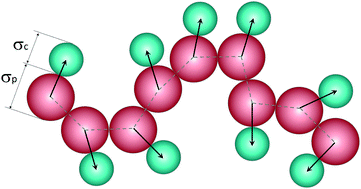An interplay of electrostatic and excluded volume interactions in the conformational behavior of a dipolar chain: theory and computer simulations†
Abstract
The effect of an interplay between electrostatic and excluded volume interactions on the conformational behavior of a dipolar chain has been studied theoretically and by means of molecular dynamics simulations. Every monomer unit of the dipolar chain comprises a dipole formed by a charged group of the chain and an oppositely charged counterion. The counterion is assumed to freely move around the chain but keeping the distance between oppositely charged ions (the dipole length) fixed. The novelty of the developed mean-field theory is that variations of the dipole parameters (the dipole length and the counterion size) have been accounted for in both electrostatic and excluded volume contributions to the total free energy of the dipolar chain. It has been shown that conformational transitions between swollen and collapsed states of the chain can be induced by fine-tuning the balance between electrostatic and excluded volume interactions. In particular, in low-polar media not only globule but also extended coil conformations can be realized even under strong electrostatic attraction. The results of MD simulations of a dipolar chain with variable dipolar length support theoretical conclusions.



 Please wait while we load your content...
Please wait while we load your content...